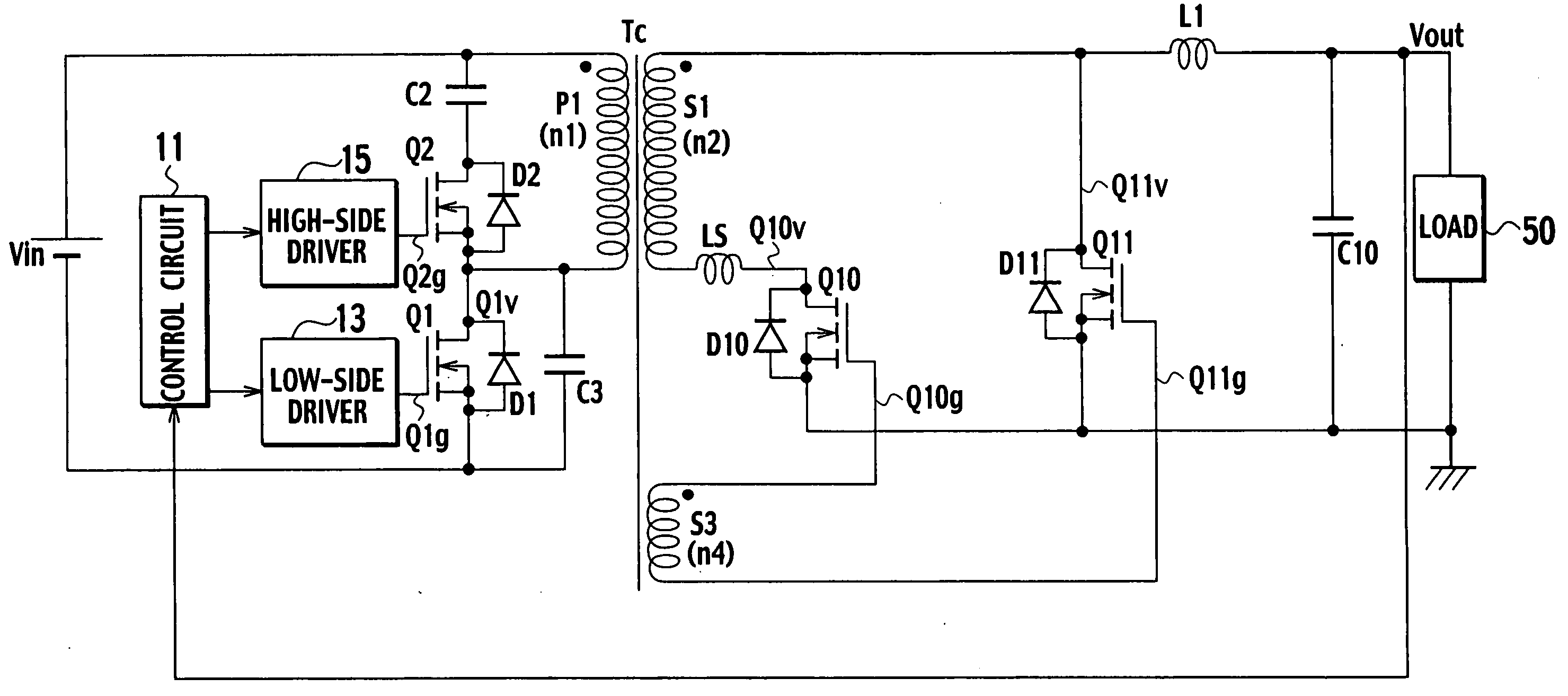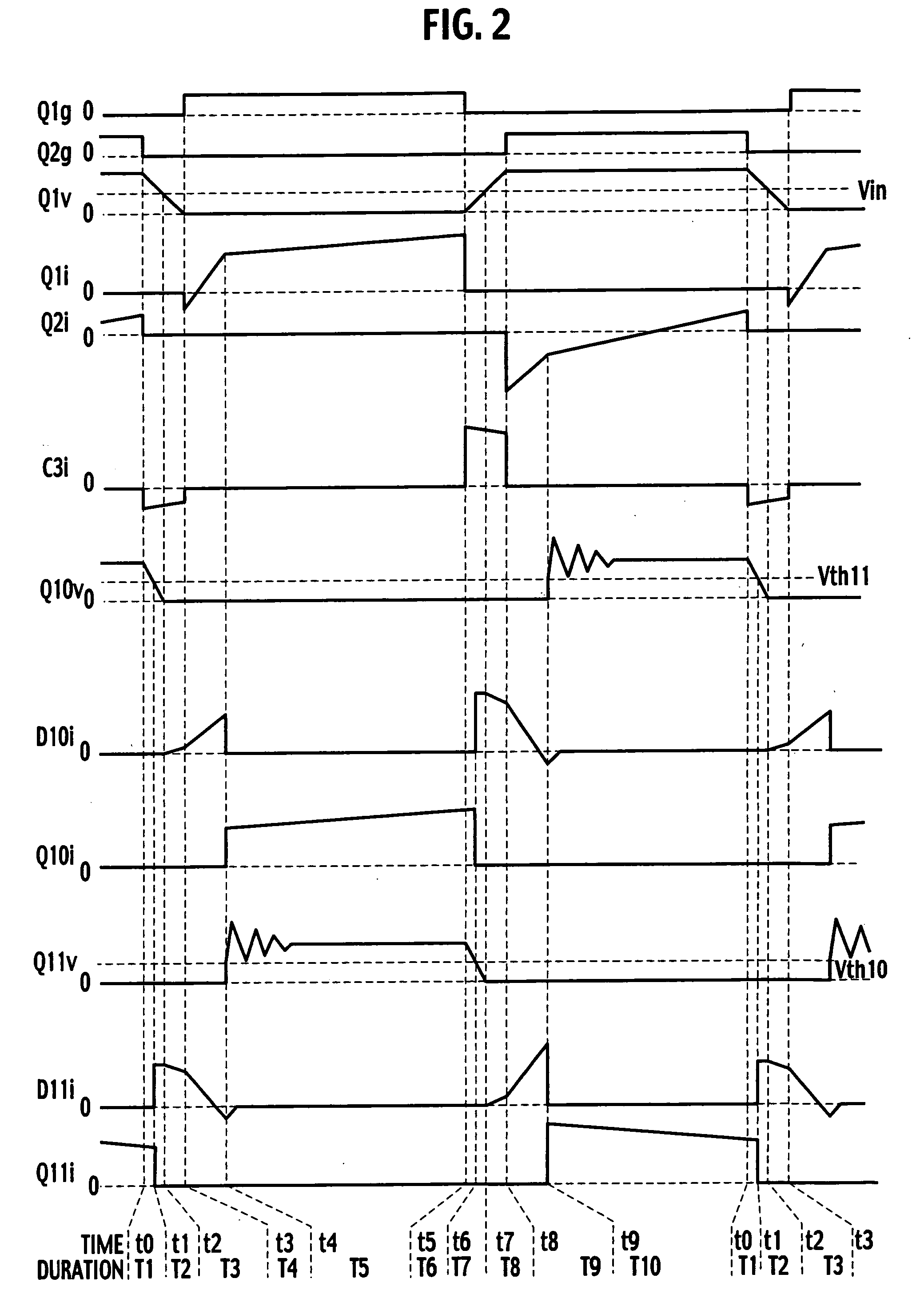DC converter
a converter and direct current technology, applied in the direction of electric variable regulation, process and machine control, instruments, etc., can solve the problems of deteriorating efficiency, synchronous rectification and power source efficiency efficiency, and synchronous rectifier chattering, so as to achieve stably driving and improve efficiency
- Summary
- Abstract
- Description
- Claims
- Application Information
AI Technical Summary
Benefits of technology
Problems solved by technology
Method used
Image
Examples
first embodiment
[0081]FIG. 8 is a circuit diagram showing a DC converter according to the first embodiment of the present invention. The first embodiment will be mainly explained in connection with parts that are different from those of the DC converter of FIG. 1.
[0082] A transformer Tc has a primary winding P1 (having the number of turns of n1), a secondary winding S1 (having the number of turns of n2) loosely coupled with the primary winding P1, and a tertiary winding S3 (having the number of turns of n4) tightly coupled with the primary winding P1. To turn on a switch Q10 when a switch Q1 is ON, the winding start of the tertiary winding S3 is connected to the gate of the switch Q10. To turn on a switch Q11 when the switch Q1 is OFF, the winding end of the tertiary winding S3 is connected to the gate of the switch Q11.
[0083] A voltage generated by the tertiary winding S3 is applied to the gates of the switches Q10 and Q11, to drive the switches Q10 and Q11. The tertiary winding S3 is tightly co...
second embodiment
[0110]FIG. 10 is a circuit diagram showing a DC converter according to the second embodiment of the present invention. In addition to the structure of the first embodiment shown in FIG. 8, the second embodiment employs a capacitor C22, i.e., a first capacitor between the winding start of a tertiary winding S3 and the gate of a switch Q10.
[0111] The capacitor C22 may be arranged between the winding end of the tertiary winding S3 and the gate of a switch Q11.
[0112] The DC converter according to the second embodiment provides the same effects as those of the DC converter of the first embodiment. In addition, the capacitance of the additional capacitor C22 is connected in series with the input capacitance (not shown) of switches Q10 and Q11 that are MOSFETs serving as synchronous rectifiers. Even if the tertiary winding S3 generates a voltage higher than the withstanding voltage of the drive terminal (gate) of each synchronous rectifier, a drive terminal voltage of the synchronous rec...
third embodiment
[0115]FIG. 11 is a circuit diagram showing a DC converter according to the third embodiment of the present invention. Parts of the third embodiment that are different from those of the related art of FIG. 3 will be explained.
[0116] A transformer Td of the third embodiment has a primary winding (having the number of turns of n1), a first secondary winding S1 (having the number of turns of n2) very loosely coupled with the primary winding P1, a second secondary winding S2 (having the number of turns of n3) loosely coupled with the primary winding P1, and a tertiary winding S3 (having the number of turns of n4) tightly coupled with the primary winding P1.
[0117] To turn on a switch Q10 when a switch Q1 is ON, the winding start of the tertiary winding S3 is connected to the gate of the switch Q10. To turn on a switch Q11 when the switch Q1 is OFF, the winding end of the tertiary winding S3 is connected to the gate of the switch Q11.
[0118] A voltage generated by the tertiary winding S3...
PUM
 Login to View More
Login to View More Abstract
Description
Claims
Application Information
 Login to View More
Login to View More - R&D
- Intellectual Property
- Life Sciences
- Materials
- Tech Scout
- Unparalleled Data Quality
- Higher Quality Content
- 60% Fewer Hallucinations
Browse by: Latest US Patents, China's latest patents, Technical Efficacy Thesaurus, Application Domain, Technology Topic, Popular Technical Reports.
© 2025 PatSnap. All rights reserved.Legal|Privacy policy|Modern Slavery Act Transparency Statement|Sitemap|About US| Contact US: help@patsnap.com



